
For anglers, fishing is all about passion. Good anglers make use of both, theoretical and practical knowledge to enhance their fishing experiences. When it comes to choosing the ideal rod, understanding the various components of a fishing rod becomes very important.
The subject of this article is to make you aware of the different parts of your fishing rod and their functions. Whether you are a beginner or an expert in this field, this article will surely help you learn and understand something new about your fishing experiences.
Importance of knowing the parts of your fishing rod
Let us start with the very first question that why it is important to know about the parts of your fishing rods. Well, the answer to this is quite simple. Whenever you start something, you learn from the basics. And when you learn about the fundamentals, you can get a hold of the concepts. Similarly, when it comes to fishing rods, if you know about the different components, you can maintain your fishing rod in a better way. This helps you in getting the most out of your fishing expeditions. Below are a handful of benefits that I have enlisted for you.
1) Choosing the right rod:
When you know about the various components of your fishing rod, you can choose the right rod for yourself. We know that different parts of a fishing rod have different functions and they have an effect on the rod’s performance. This includes casting distance, accuracy, sensitivity, and power. When you know how these components work together, you are easily able to select the best rod for your fishing style.
2) Better casting:
When you have good knowledge of the different parts of your rod such as rod guides, real seat, and blank action, you can help yourself to achieve more accurate and longer casts. When your guides are properly aligned and you have chosen a suitable seat for yourself, it becomes easier for you to place your bait where the fish are.
3) Fish handling:
Fish handling depends on the rod power and rod action. When you know about these characteristics of fishing rods, you can choose the suitable fishing rod for the target fish. A mismatched rod can make you lose the fish or go unnecessarily into long fights that stress the fish.
4) Better control:
When it comes to the control of your fishing rod, you should know about the handle and grip. They allow you to choose the most comfortable rod for yourself. For long fishing sessions, this is needed. Otherwise, you will end up having fatigue. A good grip improves the control over your fishing rod.
5) Maintenance:
Maintenance is a crucial aspect of keeping a fishing rod for a long time. Knowing about different parts helps you understand the care and maintenance needed by your fishing rod. This includes cleaning, proper storage, and recognizing when repairs are needed for your fishing rod.
6) Save cost:
Knowing about the different parts of a fishing rod can help you a lot as a beginner. You can prevent yourself from buying any unnecessary parts. This way you can save your hard-earned money during your purchases and save you the hassle of buying things that do not meet your requirements.
7) Safety:
When you have sufficient knowledge regarding various parts of your fishing rod, you can save yourself from a lot of accidents. For instance, if you know how to handle a rod with sharp hook keepers, you can prevent yourself from injuries.
8) Customization:
Sufficient knowledge of rod blanks helps you a lot in Customization. Sometimes, it even allows you to build your fishing rod. When you have a customized rod, you have a competitive edge and a personalized experience.
Parts of a fishing rod

Now that you are aware of the different benefits of knowing about the parts, let us move toward the anatomy of a fishing rod. The following are the parts of a fishing rod that I have explained in detail below.
- Rod blank
- Rod tip
- Rod guide
- Hook keeper
- Ferrules
- Windings
- Reel seat
- Rod grip
- Reel
- Fishing line
- Hooks
- Lures
- Baits
Rod blank:

The first thing that you notice is a long rod-like structure known as the rod blank. It is the foundational component of a fishing rod. It offers the main structure of the fishing rod and acts as the backbone.
Functions of rod blank:
#1:The rod blank is responsible for offering strength and flexibility. It can withstand the forces exerted during casting and fighting with the fish. It can absorb the shocks caused by fish movements.
#2: Rod blank acts as a medium of transmission between you and the fish. It transmits vibrations from the line to your hands. This sensitivity helps you in detecting auntie strikes and changes in underwear conditions.
#3: The characteristics of a fishing rod such as rod power and rod action are mostly dependent on the fishing rod.
#4: Rod blank also offers you Customization. You can choose different materials for your rod blank or you can choose to decorate it with different threads.
Types of rod blanks:
When it comes to types, there are several kinds of materials that are used for making rod blanks. Below is a list of some of the commonly used types.
#1 Graphite blanks:
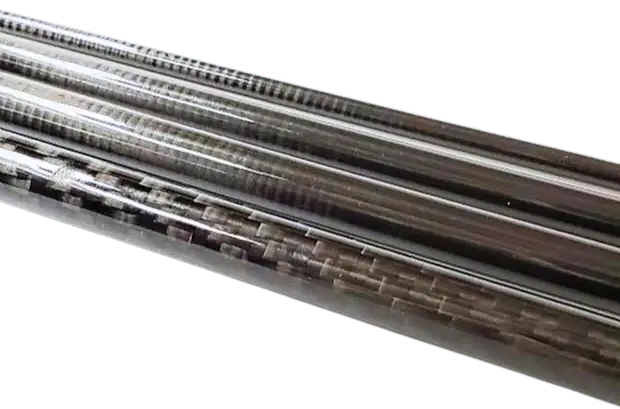
These blanks are known for their lightweight and excellent sensitivity. They also have a high strength-to-weight ratio that allows anglers to have accurate and longer casts. Graphite blanks are often used in fast-action rods for techniques like bass fishing.
#2 Fiberglass blanks:
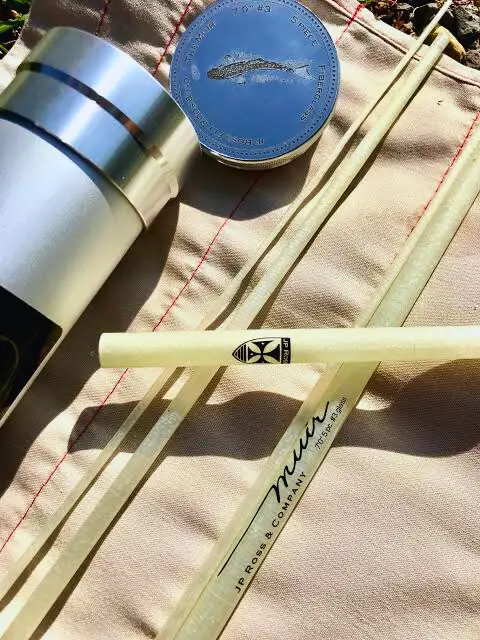
These blanks are known for their durability and flexibility. For moderate to slow action, these blanks are ideal as they absorb the shock of powerful fish. Anglers often use these blanks in trolling.
#3 Composite blanks:
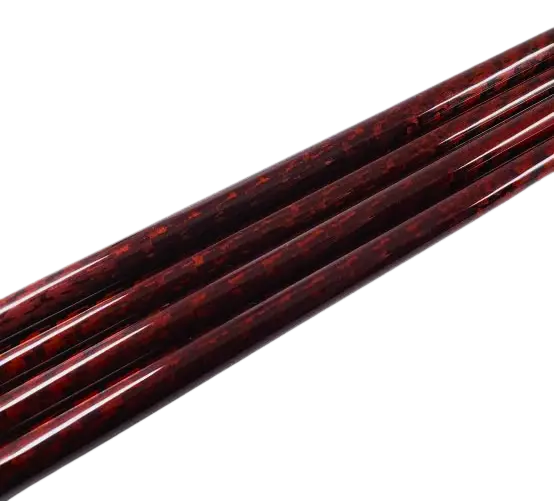
These blanks are a combination of graphite and fiberglass. They are good at offering a balance of sensitivity, strength, and flexibility. These blanks are also very versatile and can be used in various types of fishing rods.
#4 Bamboo blanks:
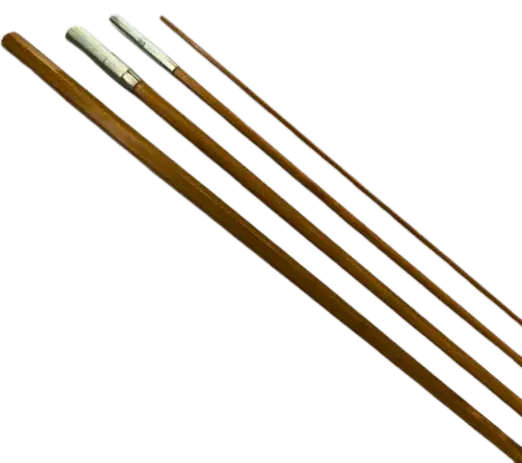
As the name suggests, these blanks have a traditional and classic appearance. They are good at providing slow motion and are often used in fly fishing rods. Most commonly these rods are known for their craftsmanship and aesthetics.
#5 Carbon fiber blanks:
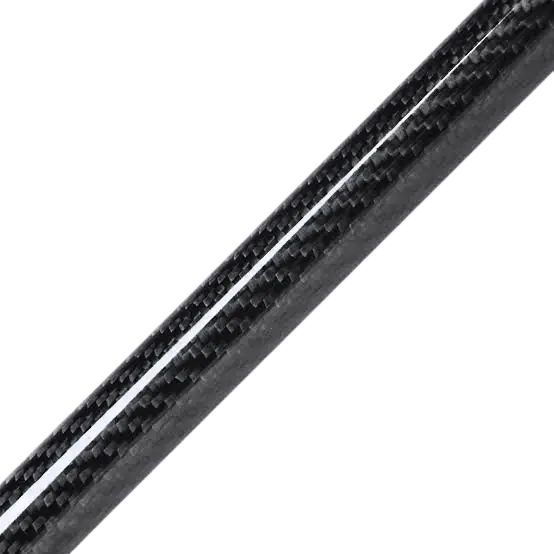
These blanks are known for their lightweight and strength. They are good at offering sensitivity and are used in high-end custom rods. For top-notch performance, these blanks are famous among anglers.
#6 Solid carbon blanks:

These blanks are entirely made up of carbon fiber. Along with being lightweight, they are good at offering exceptional sensitivity. These blanks are often found in high-end spinning and casting rods.
Can you repair a broken fishing rod blank?
Repairing your fishing rod depends on the damage that is caused. Usually, you can mend the rod blank with the help of a Fiberglass pole and epoxy. So, a little bit of effort, you can mend your fishing rod. However, if you are taking good care of it, the chances of breakage become very low.
Rod tip:
The fishing rod is the very end section of the rod and is located opposite the handle. The tip is very much like a guide however it has a different shape than the rest of the guides. It is also known as the “tip-top guide” and is a very delicate part of the fishing rod.
Functions of rod tip:
#1: The major function of the rod tip is to guide the fishing line. It makes sure that the fishing line has a smooth and controlled path.
#2: The surface of the rod tip is very smooth and has minimal friction helps anglers in achieving accurate and longer casts. It helps the line to flow freely during the casting process.
#3: We know that the tip is the most sensitive part of the fishing rod. This sensitivity helps you to observe movements and vibrations caused because of fish movement. This is a critical role that helps anglers in detecting fish bites so that they can react quickly.
#4: When you are fighting with the fish, the rod tip can absorb some of the vibrations caused by fish movements and thus becomes very helpful in shock absorption. This helps prevent the line from breaking.
#5: The tip is designed to be smooth and this way it prevents damage to the fishing line. It helps in reducing the risk of line fraying or breaking due to contact with the guide.
#6: As the tip is the topmost guide on the fishing rod, it also serves as the guide that aligns the line with the subsequent guides down the rod blank. Proper alignment is important as it ensures that the line is following the natural curve of the rod.
#7: Tip is a delicate component of a fishing rod. However, it is designed in a way to survive normal fishing conditions and strains. It may require some occasional maintenance but it is easily replaceable as well.
Types of rod tips:
You can find rod tips made of different materials and shapes according to the fishing requirement. I have enlisted some of them below.
#1 Ceramic tip-tops:
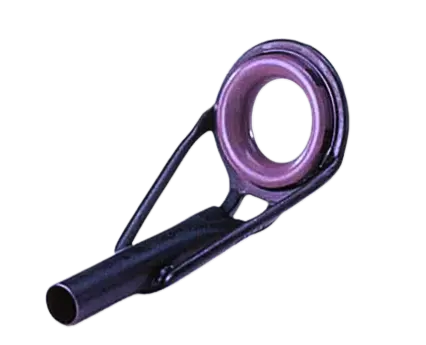
These tips are popular for the smooth surface they offer. They minimize friction on the fishing line. These tips are highly durable and are resistant to wear which makes them suitable for monofilament and braided lines. They can be used in a wide range of fishing environments.
#2 Stainless steel tip-tops:
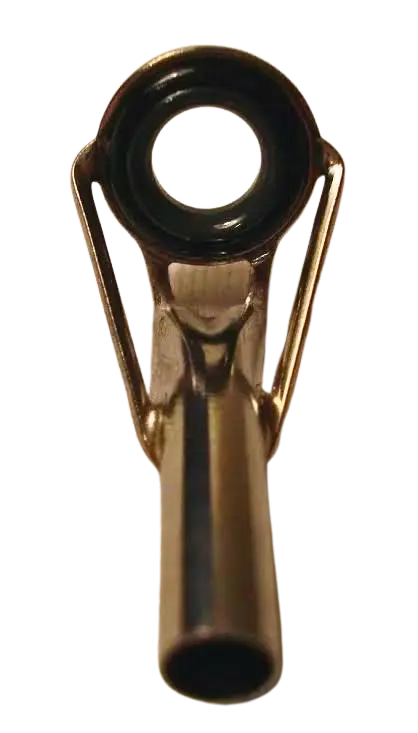
As the name suggests, these tips are made of steel which makes them resistant to corrosion and makes them very durable. They are good for heavy-duty applications and are mostly used on rods made for saltwater fishing. These tips can stand the harsh marine environment.
#3 Aluminum oxide tip-tops:
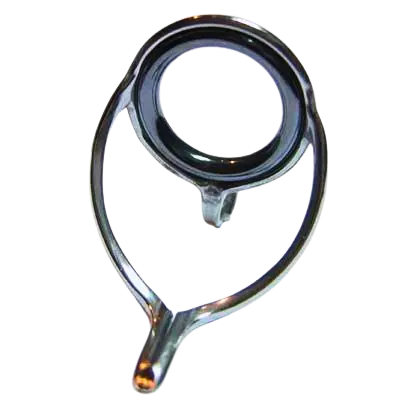
These tips are very good at providing a balance between durability and cost-effectiveness. They are resistant to wear and have a reliable performance. Their common usage is on medium to medium-heavy freshwater and inshore saltwater rods.
#4 Titanium tip-tops:
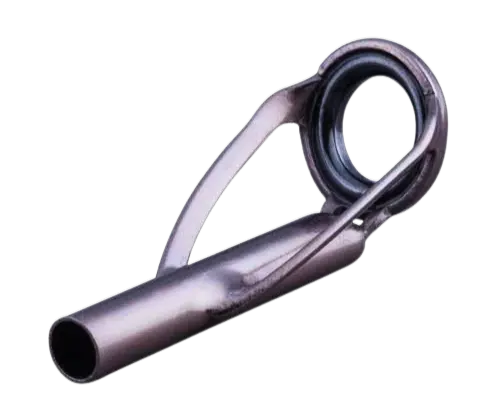
Because of titanium, these tips are lightweight and resistant to corrosion. They are suitable for the rods that are designed for sensitive and lightweight applications. Anglers who want the advantages of titanium’s strength and low weight prefer these tips on their fishing rods.
#5 High-frame tip-tops:
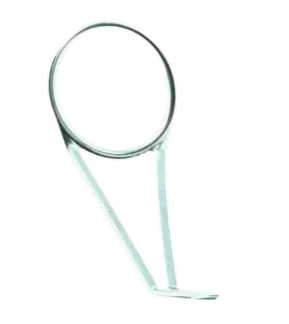
These tips are known as the higher frame that elevates the fishing line further from the rod blank. These tip-tops are used on fishing rods that are designed for heavy trolling or big game fishing.
Can you fish with a broken fishing rod tip?
Yes, you can fish with a broken rod tip. However, you will experience reduced sensitivity, less accurate casting, line fraying, inconvenience, and a high risk of losing your caught fish. So, it is always recommended to replace a broken fishing rod tip before using it for fishing.
Can you repair a broken fishing rod tip?
Yes, you can easily replace a fishing rod tip. Replacing a fishing rod tip is a lot similar to replacing a fishing rod guide, however, both components differ in their working. Make sure that the tip is aligned with the rod blank and is sensitive enough to feel the movements. Wrapping a thread around the fishing rod tip is usually not needed during replacement as it can dampen the vibrations that are necessary to detect the fish the movements.
Fishing rod guides:
They are known as the silent heroes of casting retrieving. They are small rings or loops that are attached along the length of a fishing rod. They start from the tip and end towards the foregrip of the handle. Each guide has an eye-like opening through which the fishing line can pass.
Functions of fishing rod guides:
#1: They are mostly used to control the fishing line. They keep it organized in a straight line that protects it from tangling. The straight line also offers a smooth flow and gives better control over the fishing line.
#2: Guides play a crucial role when it comes to casting. They distribute the weight of the fishing line evenly along the fishing rod which creates a balanced and accurate cast. If your fishing guides are placed properly, you will have an enhanced casting distance and accuracy.
#3: Fishing guides are also responsible for line support. When the fishing line is under any kind of tension, they prevent it from having any contact with the rod blank. This ensures that the line is in a straight path and the risk of friction is low.
#4: Guides may not have a direct impact on the sensitivity of your fishing rod. However, if they are aligned properly, they help you in receiving the maximum feedback on tension from the fishing line.
#5: Guides are also very useful when it comes to shock absorption. When the fish makes any movements, the guides help the rod distribute those vibrations evenly. This also reduces the risk of line breakage.
#6: Guides are useful for making the fishing line follow the natural curvature of the fishing rod without facing any extra tension.
#7: Different types of fishing rods have different types of guides that are suitable for different fishing environments. For instance, fly rods have specialized guides for fly lines. This makes the fishing guides versatile.
Types of fishing rod guides:
Based on material, shape, and functionality, there are many types of fishing rod guides.
Can you replace a broken fishing guide?
Yes, you can replace a broken fishing rod guide. You just have to get a similar one and replace it with the help of epoxy and wrapping thread. After replacement, your new guide will look as original as the old one.
Hook keeper:
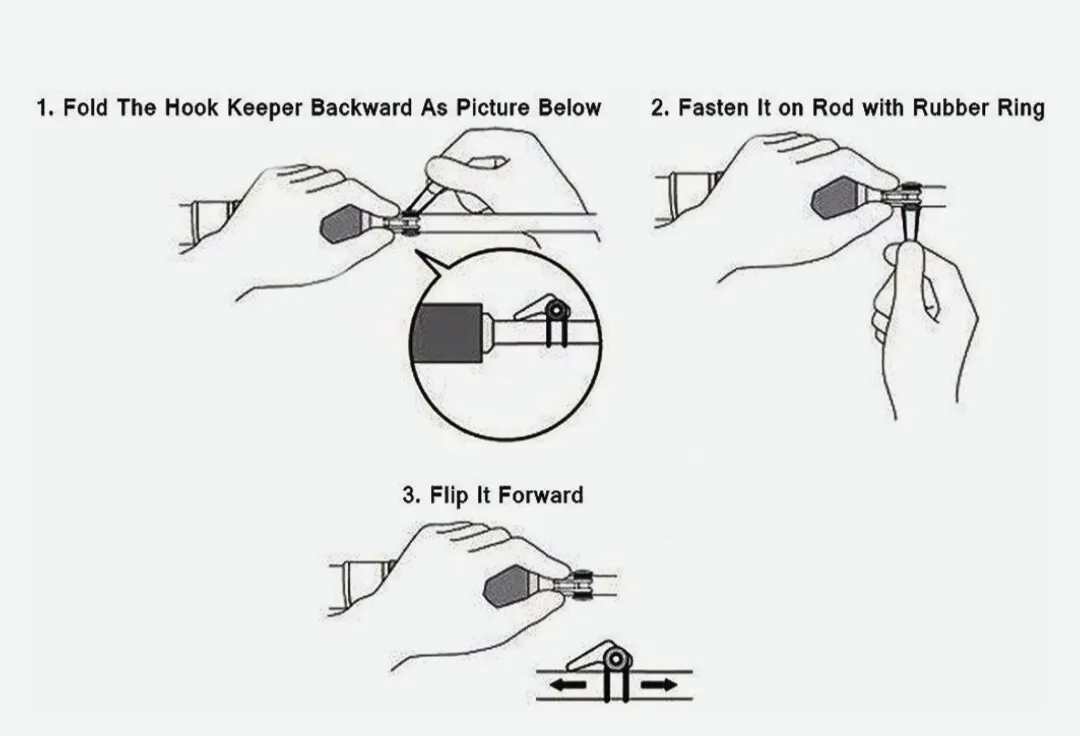
A hook keeper is a small component located on a fishing rod. The main purpose of this component is to provide a secure place for anglers to temporarily store their fishing hooks, lures, or baits. Hook keepers are small in size and come in many variations according to the material that they are made of.
Functions of a hook keeper:
#1: The main function of a hook keeper is to provide you with temporary storage for hooks. This helps you protect yourself from injuries caused by the hook. This also saves the hook from tangling with the fishing line.
#2: A hook keeper also protects your fishing line. When the hook is in a secure place, there is a low risk of the hook point accidentally damaging the fishing line.
#3: A hook keeper is responsible for providing a convenient and accessible location to attach your hook and lures. This helps you in saving your time and your fish gear is readily available.
#4: When your hook is in a secure place, you prevent the chances of tangles. Especially when you are moving through dense vegetation or navigating rough terrains. This way the hook is also less likely to snag on clothing as well.
Types of hook keepers:
Similar to the other components of fishing rods, there are several types of hook keepers as well. I have mentioned some of them below.
1) Standard hook keeper:
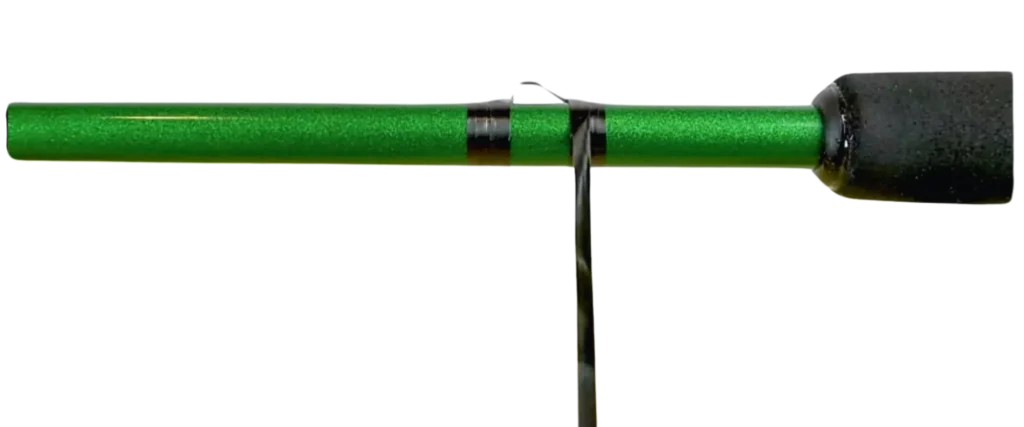
This is the most common type of hook keeper found on fishing rods. It usually has a metal loop or ring attached to the rod that is located above the handle or on the rod blank. You have to insert the hook inside the loop to secure it.
2) Folding hook keeper:
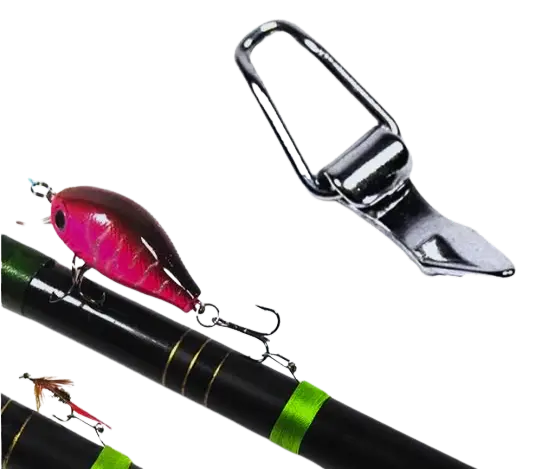
As the name suggests, this hook-keeper consists of a plastic arm that can be folded down to secure the hook. This design makes the hook keeper more effective and secures the hook in a better way.
3) Magnetic hook keeper:
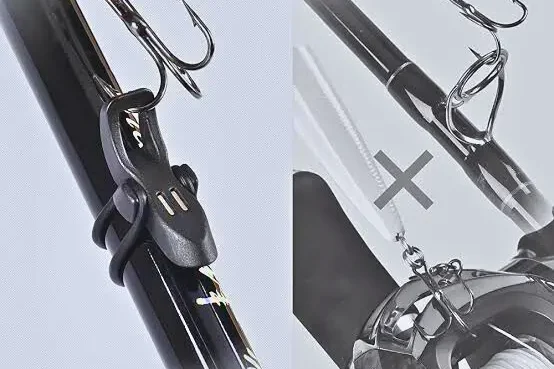
These hook keepers have a magnet to keep the hook in its place. They often consist of a magnet that is embedded in the rod blank and for this, the hook has a metal attachment. When the hook is not in use, you can attach it to the magnet.
4) Clip-on hook keeper:
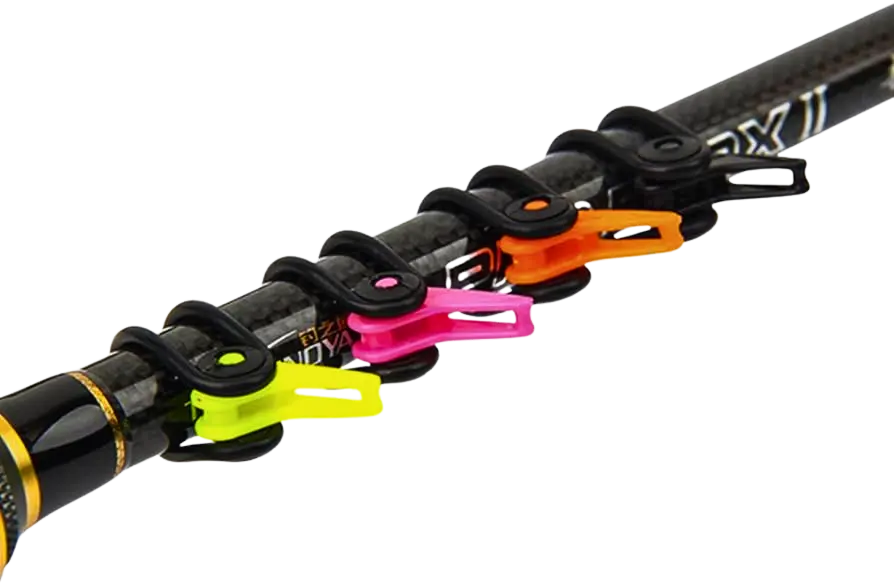
This hook-keeper acts as an attachment that can be added to a fishing rod. You can clamp these keepers onto the rod blank to provide secure storage for your hook. If you don’t have a built-in hook keeper, then this is a good choice for you.
5) Rubber hook keeper:
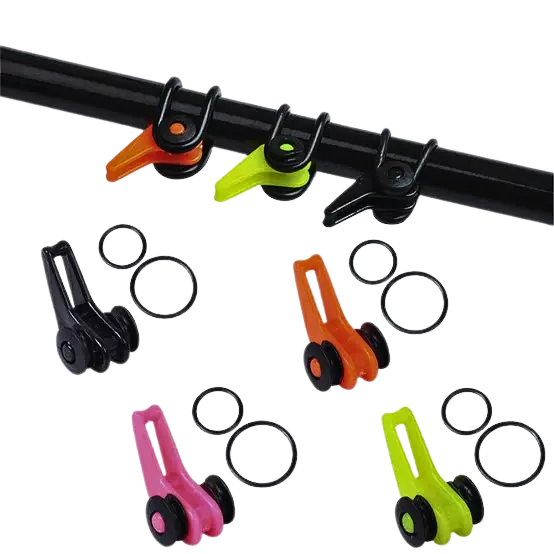
This hook-keeper is either made of silicone or soft rubber. It is known for its flexibility and can securely hold hooks, lures, or baits. These hook keepers are gentle on the line and are often used on fly rods.
Ferrules:

Ferrules are considered among the vital components of fishing rods and are found in multi-piece fishing rods such as fly, spinning, and some kinds of casting rods. A ferrule is a joint or coupling mechanism that is responsible for connecting two separate sections of a multi-piece fishing rod. It is made of different materials and is designed to be strong and durable.
Functions of ferrule:
#1: The major function of a ferrule is to provide connection as it is a kind of joint. It securely connects two-rod sections and turns them into a single and cohesive rod.
#2: A ferrule is also responsible for creating alignment. It helps in aligning the two sections of a fishing rod in a way so that the rod’s action, power, and sensitivity are not disturbed.
#3: A ferrule adds strength and stability to your fishing rod. It can withstand forces that are exerted during casting and fish fights. A reliable ferrule will save your rod from coming apart.
#4: A functional ferrule also contributes to good casting. It maintains a continuous taper along the rod’s length. This lets the fishing line move seamlessly through the guides without any abrupt changes during the rod action and rod power.
#5: Ferrules are also helpful when you have to transport your fishing rods. They allow easy assembling and disassembling of the rod sections.
Types of ferrules:
Based on design and build, you can find different types of ferrules. Some of them are listed below.
1) Spigot ferrule:
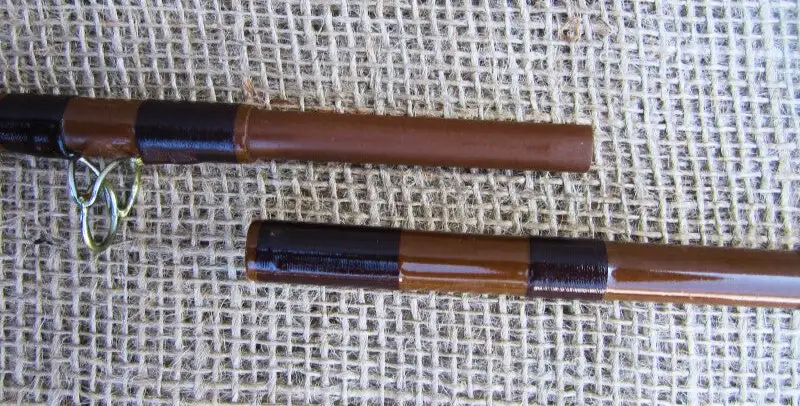
These ferrules are designed in a way that one section of the rod fits inside the other. This creates a snug and secure connection while making use of the spigot design. These ferrules provide your fishing rods with excellent alignment and strength.
2) Sleeve ferrule:

As the name suggests, this ferrule makes use of a sleeve. In this design, a separate sleeve or tube is used to connect the two-rod sections. The sleeve slides over the sections and is secured in place. It also provides your fishing rod with a stable connection.
3) Overlapping ferrule:
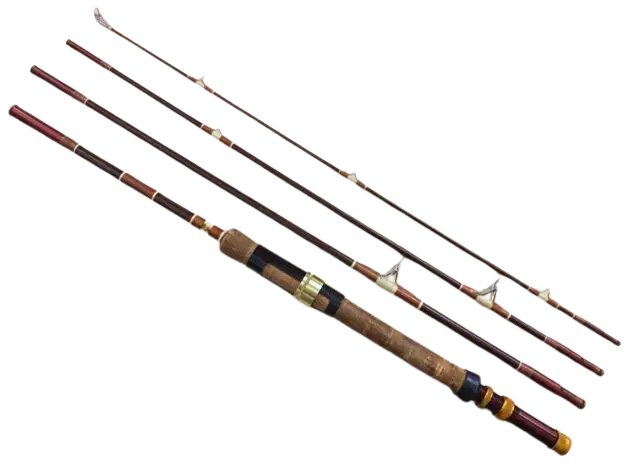
These ferrules have one-rod section that partially overlaps with the other rod section. Guide wraps are used to reinforce the joint and secure it. This kind of ferrule is commonly used in fly fishing rods.
4) Step-over ferrule:

These ferrules are similar to Overlapping ferrules. However, there is a difference in that one section steps over the other which creates a smooth transition. You can find this design in fishing rods made out of bamboo.
Can you fix a broken ferrule?
Fixing a broken ferrule depends on the damage that is caused to it. Usually, anglers can fix broken ferrules which bring back the original performance of fishing rods. However, if the damage is severe, you might have to consider replacing the ferrules entirely.
Windings or wraps:

Windings and wraps are two different names for thread wraps. They are also an integral part of the construction of a fishing rod. These wraps not only assist in functionality but also add a touch of craftsmanship and aesthetics to your fishing rod. They are decorative and structural thread wraps that are applied to various parts of the fishing rod. They are mostly used to secure guides, ferrules, and reel seats.
Functions of wraps:
#1: The major function of a wrap is to provide your rod with thread locking. They are used to secure and lock various components of a fishing rod in place. These wraps help these components to prevent moving and coming loose during usage.
#2: Wraps are also used to evenly distribute stress across your fishing rod. They distribute the stress and tension across the rod blank and reinforce connections between different parts. This reduces the risk of stress, fracture, and damage.
#3: Wraps are very helpful when it comes to damp vibrations that are caused during casting and fish fights. They help make the casts smoother and provide better sensitivity as the excessive vibrations are canceled out.
#4: Wraps are also very helpful in enhancing the grip. They provide a unique texture and grip that helps anglers in control and comfort. They are very helpful in maintaining a firm hold.
#5: Thread wraps can also be used for identification. They provide a unique look to your fishing rods. This way they contribute to the visual appeal of your fishing rod and improve the aesthetics.
Types of wraps:
There are many patterns and styles for fishing rod wrappings. However, based on position, they can be divided into five categories that are enlisted below.
1) Guide wraps:
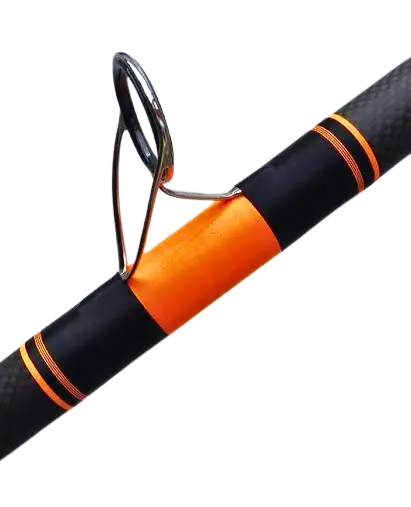
These thread wraps are used to wrap the fishing guides with the rod blank. They offer extra protection to the fishing guides. They prevent the guides from moving and help them to stay in alignment. They are also very helpful in preventing line slippage.
2) Ferrule wraps:
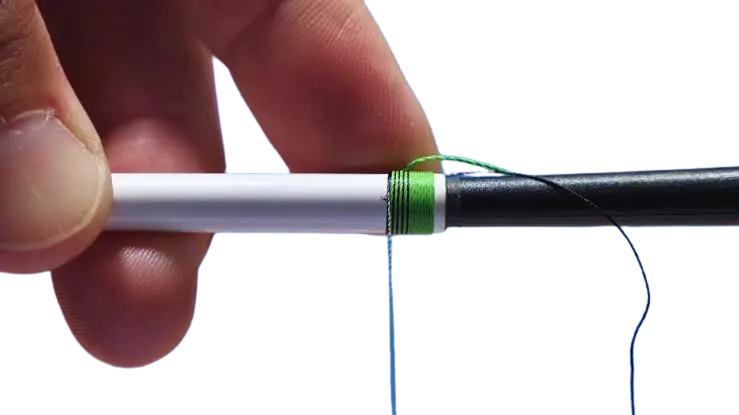
As the name suggests, these wraps are used on ferrules. In multi-piece fishing rods, they are used on ferrule connections. They help make the connections more secure. They are also very helpful when it comes to reducing the stress and strain.
3) Reel seat wraps:

These wraps are used for the rear seats. They help in keeping the reel seat in place. They make sure that the reel seat is securely attached to your fishing rod. Along with security, they add a unique look and aesthetics to your fishing rod.
4) Handle wraps:
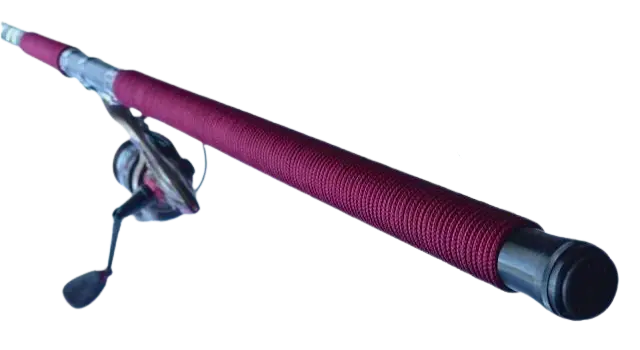
Handle wraps or grip wraps are used to provide anglers with a firm grip. They provide a comfortable grip for positioning your hands and at the same time prevent slipping. They are not used on all fishing rods. However, their most common usage is on rods with handles made of cork or foam.
5) Decorative wraps:
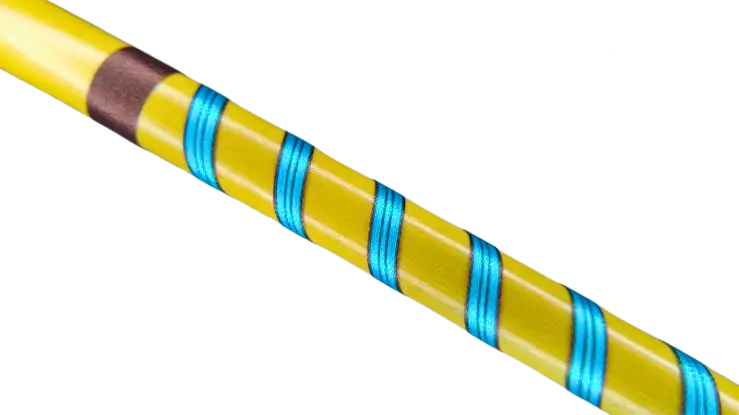
The main purpose of these wraps is to add aesthetics to your fishing rod. They have many aesthetic and intricate designs and patterns. They help add a personal touch to the appearance of your rod so it stays recognizable. They are often used by custom rod builders.
Why do you have to wrap your fishing rod?
Wrapping a fishing rod might seem like a measure for improving the aesthetics of your fishing rod. However, it also plays a major role in securing the guides. It improves the durability of your fishing rod, helps in line management, enhances the grip of the rod, and prevents it from corrosion.
Can you wrap your fishing rod yourself?
Yes, you can wrap your fishing rod yourself. Wrapping a fishing rod requires the fulfillment of some basic steps. You can get your rod wrapped or you wrap it yourself, the choice is yours. However, wrapping can be a fun activity that you can enjoy as an angler. This is the reason that most of the anglers wrap their fishing rods themselves.
If you want to learn more about fishing rod wraps, designs and how to wrap then read our detailed article “fishing rod wrapping designs”.
Reel seat:

The reel seat is an important component of your fishing rod that acts as an interface between the rod and reel. It has a huge role in securing the reel to your rod. It usually is a cylindrical or tapered structure that is made from materials such as graphite, aluminum, and composite materials. Its major components are the reel hood, locking rings, and reel foot.
Functions of a reel seat:
#1: The major function of a reel seat is to keep your reel in place. It securely holds the fishing reel and prevents it from slipping. The reel foot of the reel seat is fitted into the reel’s mounting bracket which makes sure that there is a snug and stable connection.
#2: A reel seat is also very much responsible for aligning the reel. It makes sure that the reel is aligned with the guides and fishing line. For a smooth flow, this alignment is needed.
#3: Reel seat is also responsible for adding stability to the reel’s attachment. It stops the reel from shifting or coming loose during casting, fishing, or the time when fish is on the line.
#4: Another important role of a reel seat is to provide balance to the fishing rod. Its location and design help in maintaining the rod’s balance and weight distribution. When a rod is balanced properly, it becomes efficient for casting.
#5: Another feature of the reel seat is to provide you with comfort and grip while holding the fishing rod. Reel seats are very helpful in enhancing the fishing experience.
#6: Reel seats are durable because of the materials used for their construction. They also allow you customization. With the help of reel seats, you can adjust the position of the reel on the rod according to your preferences.
Types of reel seats:
Similar to other parts of fishing rods, reel seats are also made of different durable materials. However, according to their different mechanisms, they can be divided into various types.
1) Uplocking reel seat:
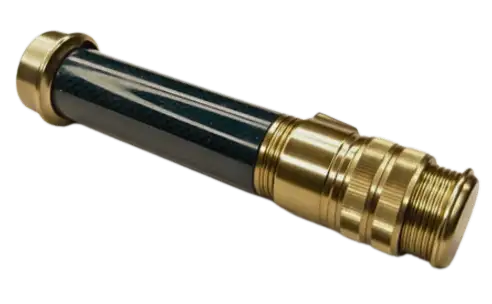
In this reel seat, the locking ring is positioned above the reel foot, which gives it the name uplocking reel. This design is known for offering a secure hold to prevent the reel from sliding upwards when there is a great load on it.
2) Down-locking reel seat:
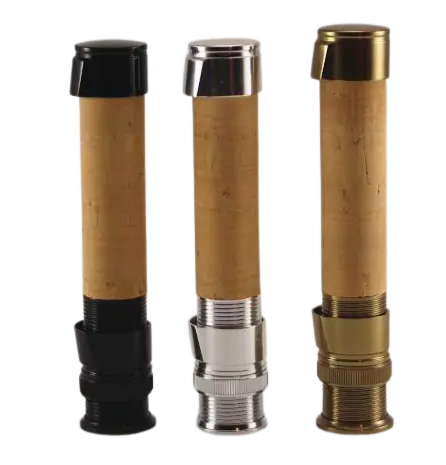
These reels are the opposite of uplocking reel seats. The locking ring in these reel seats is positioned below the reel foot. These reels are mostly used in fly rods and are good at providing better balance and weight distribution.
3) Sliding ring reel seat:
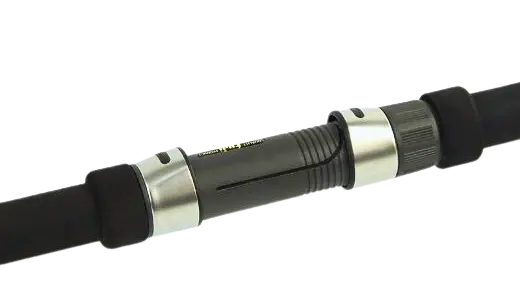
These reel seats are known for their sliding ring design. This design allows you to position the reel on your fishing rod. This way their reel seats offer you a good balance and customization according to your personal preference.
4) Trigger reel seat:
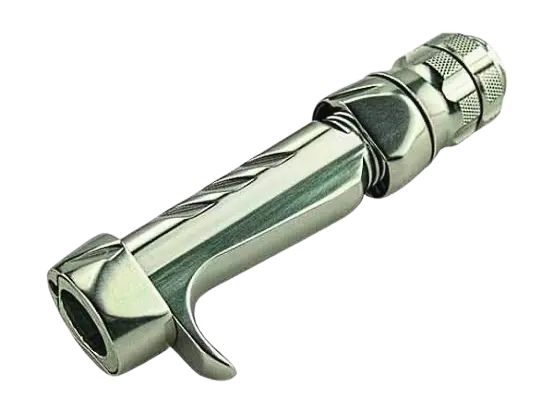
These reel seats have a pistol grip-like structure with them. This design acts like an extension and is very helpful for offering comfort and grip during casting and retrieving. The trigger reel seats are often used on casting rods.
5) Skeleton reel seat:

These reel seats are known for their minimal designs. They have cutouts that seem aesthetically pleasing but they help reduce weight and enhance the sensitivity in some fishing applications.
Can you replace a broken reel seat?
Yes, you can replace your broken reel seat but it all depends on the damage that has been caused. Depending on the type of reel seat you have, the broken piece can be replaced which saves you the hassle of replacing the whole seat. However, in some cases, you have to replace the whole seat with a new one.
Rod grip:

Rod grips are often known as rod handles. This is the part of your fishing rod that you have to hold during casting, retrieving, and fish fighting. These components are designed to fit your criteria of comfortability, control, and durability. They make sure that your grip is firm yet comfortable.
Parts of rod grip:
Foregrip:
This portion of the grip is located in front of the reel seat. It is responsible for providing you with a comfortable handhold during casting and retrieving. They can vary according to their lengths and designs.
Rear grip:
As the name suggests, the rear grip is located behind the reel seat and is also called the butt grip. During casting, you can hold it with your rear hand. They also come in various lengths and materials to suit your preferences.
Reel seat:
The reel seat is the part of the grip, where the reel is supposed to be attached. It has locking mechanisms to make sure that the reel won’t slip.
Functions of rod grip:
#1: The primary function of a rod grip is to provide you with a comfortable hold during fishing. Grips that are designed well, are good at reducing fatigue and make your adventures more pleasant.
#2: Grips play an important role in control. Good control requires a secure and comfortable grip during movements. The texture of the grip helps enhance your ability to handle the rod with precision.
#3: Grips are also very helpful in damping vibrations. This helps in increasing sensitivity because it cancels out the excessive vibrations.
#4: Grips are known for their durability. A good grip can withstand environmental factors and can survive wear and tear.
#5: Grips are also very helpful in balancing the rods. They are effective in weight distribution and make sure that the rod is balanced properly.
#6: For customization, grips offer anglers with a vast variety of materials to choose from. You can also choose grips based on their lengths and sizes.
Types of rod grips:
Grips come in various materials and designs to cater to the needs according to different fishing techniques and preferences. Below is a handful list of commonly used rod grips.
1) Cork grips:
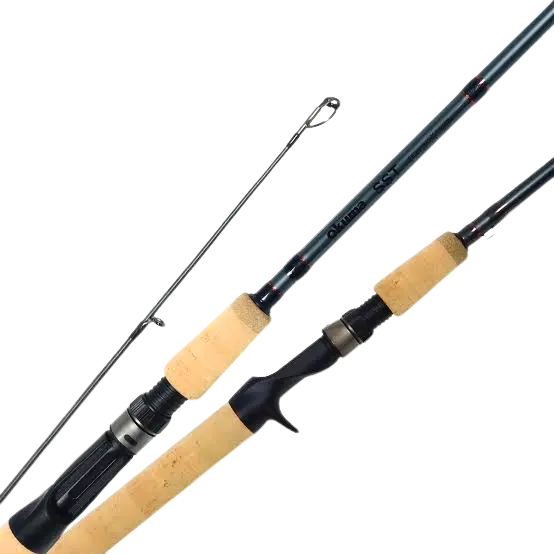
These are traditional and most popular types of rod grips. They are made of cork and offer a comfortable and natural feel along with their lightweight feature. These grips are commonly used on spinning rods, fly rods, and casting rods.
2) EVA foam grips:
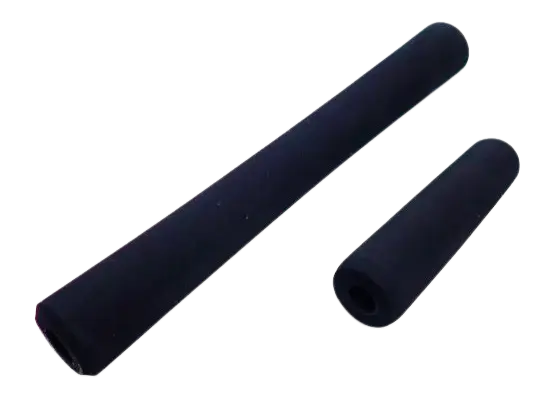
EVA stands for ethylene-vinyl acetate which is known for its durability, lightweight, and resistance to water. These grips are commonly used on fishing rods due to their comfort.
3) Rubber and composite grips:
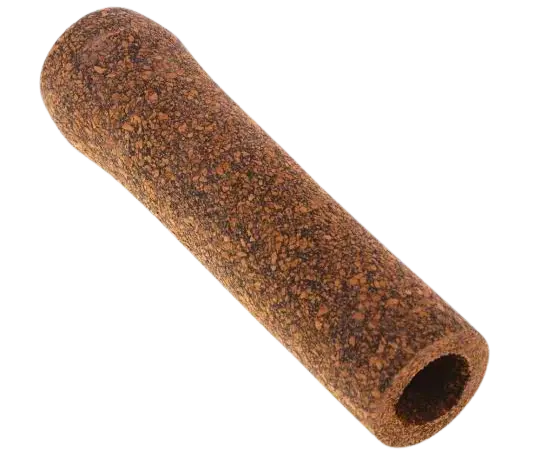
These grips are suitable for damp environments as they offer excellent grips when wet. They are durable and are found on fishing rods designed for saltwater fishing and heavy-duty applications.
4) Woven or textured grips:
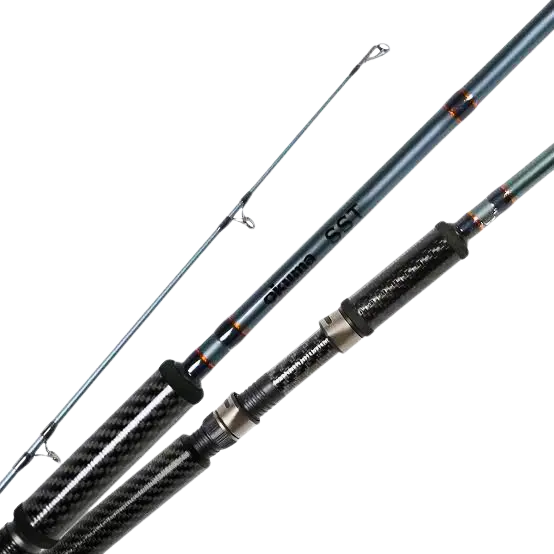
These grips are known for their woven and textured patterns that are used to enhance the grip and aesthetics. They are often used on specialty rods and custom-built rods to suit the preferences of anglers.
5) Split grips:
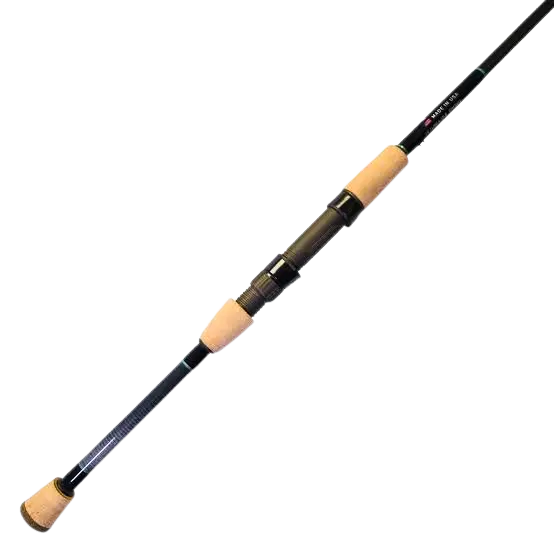
As the name suggests, these grips have a split design that has a gap between the foregrip and rear grip of your fishing rod. They help reduce the overall weight because of the gap and are used to improve sensitivity.
6) Full-length grips:
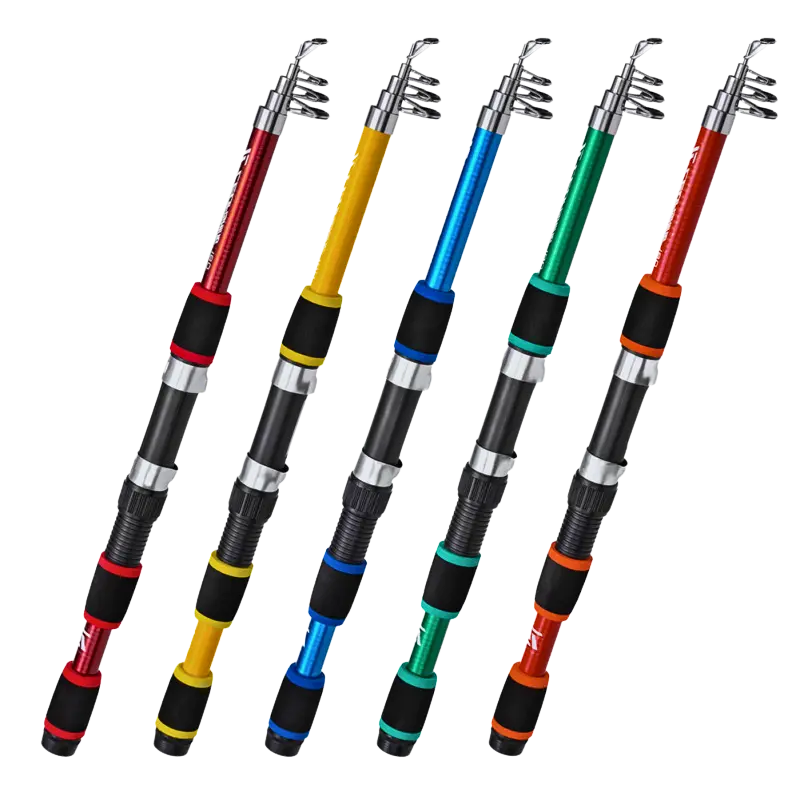
These grips are known for their extension from the foregrip to the rear grip. They provide you with continuous hand contact with the rod blank. These grips are often used on casting rods and spinning rods.
Reel:
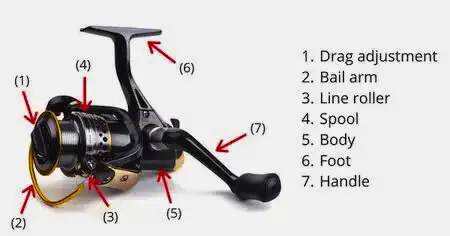
Reels are essential for storing, deploying, and retrieving fishing lines. They control the presentation of baits and lures. They come in various types and are made according to the fishing techniques and preferences.
Parts of reel:
1) Spool:
The spool is a cylindrical component of the reel that is used to hold and store the fishing line. Usually, the spool is mounted on a rotating axis and is a central part of the reel’s design.
2) Handle:
The handle is attached to the reel and is used for turning the spool by anglers. It is also useful in rotating the handle winds and for unwinding the fishing line on the spool.
3) Drag system:
The drag system is a mechanism that is used to control the amount of resistance that a fish feels when it pulls on the like. It helps set the reel to a specific drag setting so that it prevents the fishing line from breakage by force of a hooked fish.
4) Reel body:
The body of the reel is also known as the real housing. It is a frame structure that is responsible for housing the reel’s internal components. It is used to provide structural support and protection to the inner parts of the reel.
5) Reel foot:
This component of the reel is responsible for attaching it to the reel seat of a fishing rod. It is joined securely to the rod so that there is a stable connection between the reel and the rod.
6) Line guide:
You might be wondering about this component. In spinning reels, a line guide is a bail or rotor that helps in the even distribution of fishing lines on the spool. It is also responsible for guiding the lines during retrieval.
7) Bail lever or spool release:
The bail lever is a mechanism in spinning reels that is responsible for allowing the anglers to open and close the guide. This helps them in releasing and engaging the line.
8) Drag knob:
This component is used to adjust the drag resistance on the reel. As an angler, you can fine-tune the amount of pressure that is needed to reel in or let out line when a fish is hooked.
Functions of reel:
#1: Reels are mostly known for storing fishing lines. Lines are stored inside the spool that allows anglers to cast them into the water and retrieve them effectively.
#2: The drag system in reels allows anglers to set the level of resistance on the line. This is required for controlling the fish during a fight. This also prevents line breakage and protects the fishing rod.
#3: Reels also play a very significant role in casting. They are responsible for the casting accuracy and distance. Different types of reels have different casting capabilities.
#4: Bait presentation is also controlled by reels. Reels contribute to it by allowing anglers to control the speed and depth at which a line is retrieved.
#5: The weight and design of fishing reels also contribute to the balance and comfort of a fishing rod. They help a lot in an efficient fishing experience.
Can you fish with a broken fishing reel?
Fishing without a working reel is not possible. You have to either repair it or replace it. However, if you are looking to avoid the reels, there are some fishing rods such as tenkara rods that do not make use of a fishing reel to cast the fishing line.
Fishing line:
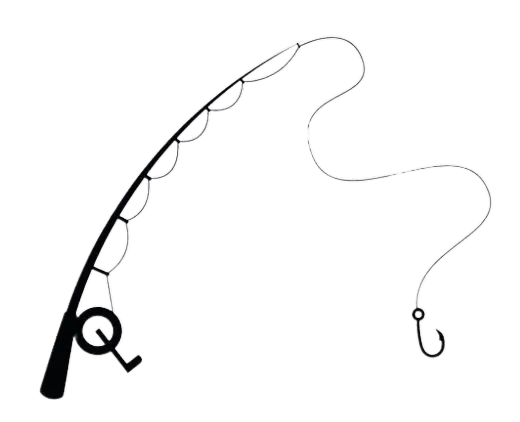
A fishing line is not an attached component of a fishing rod. However, without a fishing line, you cannot go for fishing. Whether a rod is with guides or without guides, a line is always necessary. A fishing line is a thin, flexible, and durable strand that is typically made up of various materials. It is wound onto the reel spool which allows the anglers to present bait to the target fish.
Functions of fishing line:
#1: The major feature of a fishing line is to withstand the forces that are exerted on it when a fish is hooked. Different types of fishing lines have different levels of strength.
#2: Fishing lines act as an invisible connection to the seawater. They link your fishing rod with the target fish.
#3: Fishing lines are also very helpful when it comes to shock absorption. Their elasticity contributes a lot to this factor.
#4: Fishing lines also act as a medium for transmitting sensitivity. They transfer the vibrations of fish movement from the fish to the fishing rod.
Final words
Finally, I would like to say that knowing about your fishing rod will always help you. If you know better about your fishing rod, you can not only repair it yourself, but you can also become efficient in maintaining it. So, invest some of your time in understanding and learning new things about your fishing rod.

3 thoughts on “parts of a fishing rod and Reel, There types and functions”